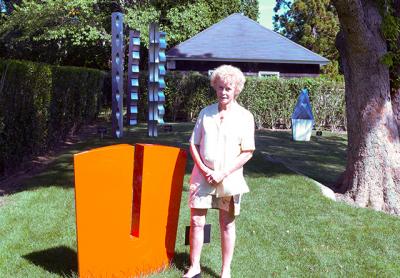Carol Ross: Exploring Her Mediums

Some artists discover their medium and stick with it. Throughout most of her career, Carol Ross has shifted artistic gears with apparent ease between wood reliefs, metal sculpture, drawing, and painting. “I’m an artist who changes a lot,” she said during a recent conversation in Guild Hall’s sculpture garden, where her large aluminum pieces can be seen through Oct. 1. A selection of her wood reliefs is also on view in Guild Hall’s Wasserstein Family Gallery.
Surrounded by her sculpture in the garden, she said, “As a sculptor, you’re very earthbound. The piece has to stand. As a painter, you’re totally free. I’m fascinated that I ended up making sculpture like this. As a student, I said, ‘Sculpture? No way.’ I wouldn’t even take a class in sculpture.”
Ms. Ross decided after her metal sculpture was installed at the Watermill Center four years ago that she needed a break and turned back to painting. “Last summer I painted, not too successfully,” she said. “This summer I’m painting very unsuccessfully. I might start drawing again and give up on the paintings. I have five or six different things I want to do all at once.”
Her student days started quite early. “By the time I was 13, I was going to the Art Students League.” She took classes there and at studios closer to her family’s home in Roslyn and, with her mother’s help, she had her own studio in the basement of a medical office building when she was 15. At the time, her painting was Abstract Expressionist. “It was the 1950s, what else did you do?”
A self-described teenage beatnik, she and her friends hung out in Greenwich Village and frequented the art galleries on 57th Street. When she left for the University of Michigan, “I was not interested in anything except art. There were a lot of forward-thinking faculty and my freshman year they had a happening on top of a parking garage. Claes Oldenberg, Robert Rauschenberg, and John Cage took part.”
After graduate school at New York University and a year in Ibiza — “I was a real hippie then” — and a few odd jobs in New York City, Ms. Ross was hired to teach at Stevens College, a women’s school in Columbia, Mo. “They gave me a studio in the cupola of a three-story building, and I made some of the best paintings of my life there. I had always been interested in abstraction, and that was when I got the connection between the landscape and abstraction. I made calligraphic paintings with washes of thin colors.”
Another turning point came when she returned to New York. John Coplans, a photographer, artist, curator, and longtime editor of the influential journal Artforum, became a mentor. One day he said, “ ‘You’re never going to get anywhere until you make something you can’t make.’ That’s when I started with the wood reliefs, because I couldn’t make them. I needed a fabricator.”
The wood reliefs at Guild Hall are elaborately shaped pieces of plywood with curvilinear segments of veneer. The shapes are organic, as are most of the titles — “Gull,” “A Seed Lifting on a Breeze,” for example — and exemplify how nature and abstraction combine in her work. The veneers are ash, cherry, ironwood, and walnut. Their shapes intertwine in complicated patterns so that the differently colored woods play off one another.
Her aluminum sculpture has a more angular geometry than the reliefs and an almost Minimalist symmetry. Enhanced by a bright palette that includes a lot of orange, red, and blue, most of the pieces have unique bases, each of which is designed as part of the overall work.
Speaking of working with metal, she said, “I always do drawings first. The hardest part is getting a shape that’s really unique and interesting. It can take me a year, easily. I’ll have a stack of drawings before I move to the next step, which is to make a model or maquette. I do so much prep work in part because it’s so expensive to do metal work. I’ve made a few mistakes, but I try really hard not to.”
The maquettes are cardboard. At first she had them made full size, but her metal fabricator was so good she was able to scale the models down. “He does aluminum welding. It’s amazing how refined his work is.” All the metal pieces are finished with automobile paint at Corwith’s Auto Body in Water Mill.
Many of the metal pieces, too, allude to the landscape, with titles such as “Urban Moon,” “Ravine,” “Gorge,” and “Petit Piton,” the latter based on drawings she made in Trinidad and Tobago. The exhibition at Guild Hall has inspired her to take up metal sculpture again when she returns to New York City in the fall.
Ms. Ross has spent the last 25 summers in a house on the bay in Noyac. “You have a total view of the water. It was very run down, but that didn’t scare me after having renovated a loft.” Such things became even easier in 1995, when she met and married Vladimir Kasa-Djukic, an architect who at that time was modifying Chuck Close’s studio. She also has a 5,000-square-foot loft on West 26th Street in Manhattan.
Ms. Ross has a 36-year-old daughter, Jackie, from an earlier marriage, and two grandchildren, who visit every weekend in summer. She makes time to work in her garden a couple of hours each day and has begun photographing its flowers. “I’m starting to think about a book of garden photographs. I’ll call it either ‘The Ecstatic Gardener’ or ‘The Ecstatic Garden.’ ” One of the “five or six different things” she’s working on or thinking about, it’s likely to find its way into print.
